Beta Arae
Beta Arae (β Ara, β Arae), the brightest star in the constellation of Ara, is a very luminous, relatively young, giant star with an apparent visual magnitude of 2.8 (rounded).[2] Parallax measurements place it at roughly 650 light-years (200 parsecs) from Earth.[1]
 | |
| Observation data Epoch J2000 Equinox J2000 | |
|---|---|
| Constellation | Ara |
| Right ascension | 17h 25m 17.98835s[1] |
| Declination | −55° 31′ 47.5868″[1] |
| Apparent magnitude (V) | 2.84[2] |
| Characteristics | |
| Spectral type | K3 Ib-II[3] |
| U−B color index | +1.56[4] |
| B−V color index | +1.46[4] |
| Astrometry | |
| Radial velocity (Rv) | −0.30±0.20[3] km/s |
| Proper motion (μ) | RA: −8.51[1] mas/yr Dec.: −25.24[1] mas/yr |
| Parallax (π) | 5.05 ± 0.64[1] mas |
| Distance | approx. 650 ly (approx. 200 pc) |
| Absolute magnitude (MV) | −3.494[5] |
| Details | |
| Mass | 8.21[6] M☉ |
| Luminosity | 5,636[6] L☉ |
| Surface gravity (log g) | 1.20[6] cgs |
| Temperature | 4,197[6] K |
| Metallicity [Fe/H] | −0.05[6] dex |
| Rotational velocity (v sin i) | 5.4±1.0[3] km/s |
| Age | 50.1±4.4[7] Myr |
| Other designations | |
| Database references | |
| SIMBAD | data |
The spectrum of this star matches a stellar classification of K3 Ib-IIa,[3] with the luminosity class notation 'Ib-IIa' indicating that the star lies part way between a higher luminosity bright giant (IIa) and a lower luminosity supergiant (Ib). This represents two of the evolutionary stages that a massive star passes through after it has exhausted the hydrogen at its core. Beta Arae is radiating energy from its outer envelope at an effective temperature of 4,200 K, which causes it to take on the orange hue of a K-type star.[9] This enlarged star appears to be rotating slowly with a projected rotational velocity of about 5 km/s.[3] The abundance of elements other than hydrogen and helium, its metallicity, is more than three times that of the Sun.[3][lower-alpha 1]
Rarely, this star is called Vasat-ül-cemre a Turkisation of Arabic وسط الجمر (wasaṭ al-jamar), meaning "middle of the embers."[10] The constellation is named in Arabic المجمرة (al-mijmarah), meaning brazier/incense-burner.[11] In Chinese, 杵 (Chǔ), meaning Pestle, refers to an asterism of β, σ and α Arae.[12] The Chinese name for β Arae is 杵三 (Chǔ sān, English: the Third Star of Pestle.)[13]
Notes
- The abundance is estimated by taking [Fe/H] to the power of ten, thus:
10[Fe/H] = 10+0.5 = 3.1
References
- van Leeuwen, F. (November 2007). "Validation of the new Hipparcos reduction". Astronomy and Astrophysics. 474 (2): 653–664. arXiv:0708.1752. Bibcode:2007A&A...474..653V. doi:10.1051/0004-6361:20078357.
- Wielen, R.; et al. (1999). "Sixth Catalogue of Fundamental Stars (FK6). Part I. Basic fundamental stars with direct solutions". Veröff. Astron. Rechen-Inst. Heidelb. Astronomisches Rechen-Institut Heidelberg. 35 (35). Bibcode:1999VeARI..35....1W.
- De Medeiros, J. R.; et al. (November 2002). "A catalog of rotational and radial velocities for evolved stars. II. Ib supergiant stars". Astronomy and Astrophysics. 395: 97–98. arXiv:1312.3474. Bibcode:2002A&A...395...97D. doi:10.1051/0004-6361:20021214.
- Johnson, H. L.; et al. (1966). "UBVRIJKL photometry of the bright stars". Communications of the Lunar and Planetary Laboratory. 4 (99): 99. Bibcode:1966CoLPL...4...99J.
- Cassatella, A.; Altamore, A.; Badiali, M.; Cardini, D. (2001). "On the Wilson-Bappu relationship in the Mg II k line". Astronomy and Astrophysics. 374 (3): 1085. arXiv:astro-ph/0106070. Bibcode:2001A&A...374.1085C. doi:10.1051/0004-6361:20010816.
- Heiter, U.; Jofré, P.; Gustafsson, B.; Korn, A. J.; Soubiran, C.; Thévenin, F. (2015). "Gaia FGK benchmark stars: Effective temperatures and surface gravities". Astronomy & Astrophysics. 582: A49. arXiv:1506.06095. Bibcode:2015A&A...582A..49H. doi:10.1051/0004-6361/201526319.
- Tetzlaff, N.; Neuhäuser, R.; Hohle, M. M. (January 2011). "A catalogue of young runaway Hipparcos stars within 3 kpc from the Sun". Monthly Notices of the Royal Astronomical Society. 410 (1): 190–200. arXiv:1007.4883. Bibcode:2011MNRAS.410..190T. doi:10.1111/j.1365-2966.2010.17434.x.
- "bet Ara -- Star". SIMBAD. Centre de Données astronomiques de Strasbourg. Retrieved 2012-01-15.
- "The Colour of Stars". Australia Telescope, Outreach and Education. Commonwealth Scientific and Industrial Research Organisation. December 21, 2004. Archived from the original on 2012-03-18. Retrieved 2012-01-16.
- "YILDIZ ADLARI SÖZLÜĞÜ" [Glossary of Star Names - V]. Mustafa Pultar (in Turkish). Retrieved 2020-03-04.
- "Ara". Google. Retrieved 2020-03-04.
- 陳久金 (2005). 中國星座神話 [Chinese horoscope myth] (in Chinese). Wunan Book Publishing Co. ISBN 978-986-7332-25-7.
- "天文教育資訊網". AEEA (Activities of Exhibition and Education in Astronomy) (in Chinese). 2006-07-01. Retrieved 2020-03-04.
External links
- Kaler, James B., "BETA ARA (Beta Arae)", Stars, University of Illinois, retrieved 2012-01-15
- HR 6461
- Image Beta Arae
